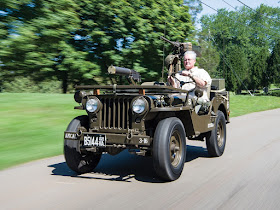By JIM
PURCELL
In 1983, I
was 17 years old and had just returned to my Army Reserve unit in Bristol,
Pennsylvania after graduating Infantry School at Fort Benning, Georgia. I had
to bum a ride with another soldier in the unit to get to the drill, because I
didn’t drive yet. But, in my first weekend back, I was told to report to the
Motor Pool, where I learned how to drive an M113 Armored Personnel Carrier and
a jeep.
 |
| The M38 Jeep became a legend during World War II |
My father
fought in World War II (1941-1945) as a combat engineer. He sometimes talked
about jeeps, and praised them for their flexibility, reliability and relative
ease in repairing. Many of my cousins served in the Army or Marines and they
held jeeps in high regard also. It could be argued that the continuity between
my father’s days in uniform and mine was the jeep.
So many
things had changed between the 1940s and 1980s: uniforms, rifles, rations, head
gear, you name it and it changed. But, what hadn’t changed all that much was
the Army’s workhorse, the jeep.
HOW THE
JEEP BEGAN
In 1939,
the U.S. Army began standardizing many of its military vehicles by payload.
Five categories were recognized: half-ton through 7 ½-ton. Yet, by 1940, the
War Department also identified a need for a new vehicle, specifically a ¼-ton,
cross-country reconnaissance vehicle. So, the U.S. Army solicited proposals
from 135 domestic car manufacturers for this new vehicle.
 |
| The M606A2 Jeep was successor to the M38 |
Bids were
received back to the Army in just 11 days, when the War Department gave
prospective jeep manufacturers 49 days to create a prototype vehicle and an
additional 70 days to put those prototypes through a series of tests outlined
by the War Department.
The War
Department required that the new ¼-ton truck would have to be four-wheel drive,
include a crew of three on a wheelbase of no more than 75 inches (that was
later changed to 80 inches), feature a fold-down windshield, carry a 660-pound
payload and be powered by an engine capable of 85 lb-ft (115 Nm) of torque. It
also had to weigh no more than 1300 pounds when empty.
During
1941, the Quartermaster Corps released a memorandum that stated the design of
the ¼-ton truck would not be the property of any one manufacturer. I don’t
recall this provision ever being imposed on a model design, before or since.
 |
| The M151 Jeep fought the Vietnam War |
The first
companies to come up with working prototypes were American Bantam and
Willys-Overland. Ford would later join the small club of jeep producers. As it
turned out, Willys was the low-bidder, but the company requested additional
time on its prototype so it was penalized by the War Department. Meanwhile,
Bantam had enlisted the talents of notable Detroit vehicle designer Karl
Probst.
Though
Bantam was in the race to develop the jeep, it did not have the production
capabilities of either Willys or Ford. So, Willys created the “Quad” and Ford
made the “Pygmy.” Bantam would go on to produce the BRC-60. The vehicles were
so similar, though, that all three of the prototypes were declared acceptable
and 1500 units were ordered by the government from each company. And, though
all of the vehicles purchased by the government would go on to be called
“jeeps,” it is lost to history about how that name came to characterize the
¼-ton truck.
 |
| The M422 "Mighty Mite" jeep |
However,
there is some speculation that the word “jeep” came about from the phrase “General
Purpose” or “GP,” which is often used in military circles.
THE
IMPORTANCE OF JEEPS
The
contribution of the jeep in World War II was everything that the War Department
and its producers hoped it would be. In fact, Army Chief of Staff General
George C. Marshall called the new truck “America’s greatest contribution to
modern warfare.”
It is
widely believed that the creation of the jeep was the spark that later led to
civilian jeeps and even contemporary sports utility vehicles.
 |
| U.S. Gen. George Marshall |
In 1950,
the first post-World War II jeep was produced for the military, dubbed the M38
by the uniform services. This was followed up by the M38A1. It even came in an
ambulance version, known as the M170.
The jeep would later be modified into the M606A2 and M606A3, with the
CJ-5 developed for governments friendly to the United States.
By the
Vietnam War, the jeep was christened the M151, which had unibody construction.
The Marines had their own version of the jeep constructed, the M422 “Mighty
Mite,” which was made smaller and more portable.
Though the
jeep was replaced in the military’s inventory beginning in 1981, by the
High-Mobility, Multi-Wheeled Vehicle (HMMWV), the length of service the jeep
rendered to the U.S. military could be counted in decades.
Jeeps can
still be found in militaries throughout the world. These vehicles have earned a
special place in the history of warfare, and are a unique contribution for the
world by the United States.





















